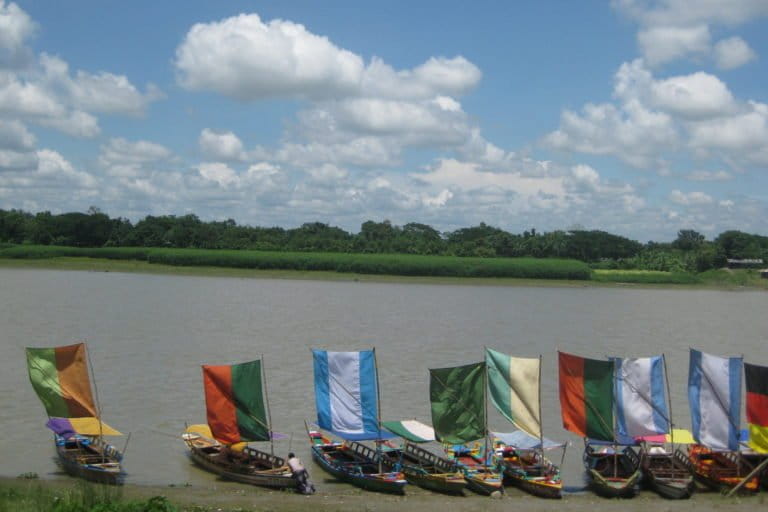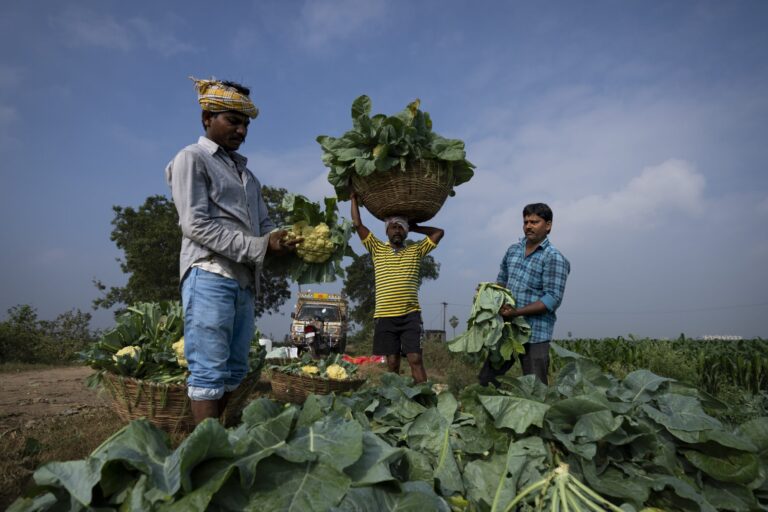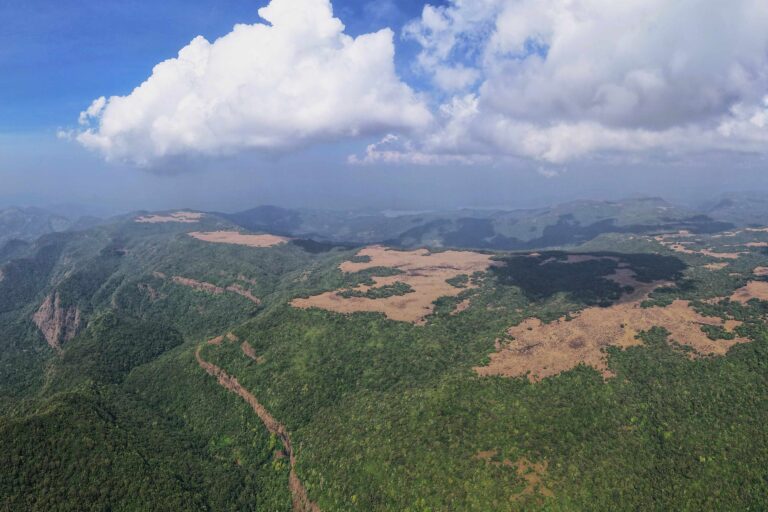- Transboundary cooperation between Brahmaputra basin countries is needed to ensure the sustainability of the river basin and improve the lives and livelihoods of its communities, says a recent study.
- The Brahmaputra river basin is based within China, India, Bangladesh and Bhutan. In China, the river is no longer free flowing because of the construction of dams.
- The river is managed differently in the different basin countries based on their respective national policies. Conflicts that exist among the basin countries over management of the shared rivers need to be addressed through adaptive hydro-diplomacy that exceeds conventional diplomatic practices.
The transboundary Brahmaputra basin needs to be viewed as a single entity so that collaborative and cooperative actions will help the region to move gradually towards sustainable development, say researchers from International Centre for Integrated Mountain Development (ICIMOD) and Aaranyak, in a recent study.
The study, Sustainable Management Options for Healthy Rivers in South Asia: The Case of Brahmaputra published in Sustainability Journal, says that to ensure the sustainability of the Brahmaputra river basin and improve the quality of lives and livelihoods of its communities, all basin countries should have relevant national level policies, a coherent and cooperative basin-level integrated management plan, and a robust knowledge base of future scenarios built around ongoing and anticipated changes in the basin’s natural, socioeconomic, and development systems.
The Brahmaputra, which originates in the Chemayungdung glacier in the Kailash range in the south of the Tibet Autonomous Region (at a 5300 m elevation), traverses China (for a distance of 1625 km), India (for 918 km), and Bangladesh (for 337 km, where it is called Jamuna). It merges with the Ganges (Padma) and then with the Meghna in Bangladesh, and eventually flows into the Bay of Bengal. The Brahmaputra river basin (BRB) is based within China (50.5%), India (33.6%), Bangladesh (8.1%), and Bhutan (7.8%).
The study says it is time to advocate for the ecological health of the rivers in this basin to keep them free flowing, for which a basin level collaborative mechanism is indispensable, without which the existing threats will multiply and the basin dwellers will lose the benefits of the natural ecological services as well as planned derived benefits of the rivers and their vast water resources.
Importance of maintaining ecological health of rivers, threat from unsustainable interventions on rivers, challenge of impact of climate change, and disaster risk reduction warrants transboundary cooperation.
The Brahmaputra river basin is key to the growth of the South Asian region because it is critical to meeting the demands for water and its uses for people and their livelihoods. “In the changing context of the projected climate future, there is a need to balance the multiple demands for water between environmental management, social equity, and sustainable development of the basin communities and ecosystem. With increasing population and changing consumption patterns, it is likely that the demand for water from the Brahmaputra will rise, putting the basin’s social, political, and economic stability at risk,” the authors say in the paper.
The Brahmaputra is one of the largest river systems of South Asia, providing life-supporting services to about 70 million people. Massive flooding, land erosion, over-exploitation of water, excessive fishing, habitat degradation and fragmentation, exploitation of flood plains, climate change impacts, absence of integrated basin wide management, and transboundary cooperation are major challenges for the present and future sustainability and development in the basin.
The basin sustains a population of more than 80 million people, comprising more than 200 indigenous, multi-ethnic communities with an average density of 182 persons sq km. About 97% (78 million) of the total population of the river basin live in India and Bangladesh — two of the most populous countries in South Asia.

Neera Shrestha Pradhan of ICIMOD told Mongabay-India that the paper emphasised the need for an integrated management and governance mechanism among the basin countries with the objective of equitable benefit sharing, upstream-downstream linkages, disaster risk management, and resilience building approaches for a durable future of the river and its communities.
“The Brahmaputra is one of the largest river systems of South Asia, but has very inadequate understanding of future scenarios encompassing its physical, climatic, ecological, and social regimes. It is also known for its large variation in endemic flora and fauna and provides livelihood support to its inhabitants. The mismatch between water supply and demand for various sectors of water users leads to major challenge” she says.
“Being a transboundary river, the Brahmaputra is managed differently in the different basin countries based on their respective national policies and practices. One of the major challenges of a shared basin is that there is little effort at collaborating and cooperating in the generating and sharing of scientific data between and among the countries. “A similar situation prevails relating to collaboration between communities upstream and downstream, as well as across borders” she says.
Partha Jyoti Das from Aaranyak told Mongabay-India, “We have provided a multidimensional and inclusive basin level account to drive home the point that it is time to advocate for upkeeping ecological health of the rivers in this basin, which is absolutely necessary to sustain the values of rivers and the benefits provided to nature and human societies by rivers and riverine ecosystems.”
Read more: Ancient tree rings shed light on Brahmaputra flood risk
Need to keep the rivers free-flowing
The study says long-term sustainable benefits cannot be achieved/ensured only by sectoral and nationally differentiated perspectives and plans. It says there is a “need to keep rivers free flowing” as far as possible as an entry point to argue for a “collaborative co-management mechanism for the Brahmaputra river and its basin”.
The significance of river connectivity — longitudinal (river channel), lateral (floodplains), vertical (groundwater and atmosphere), and temporal (intermittency) — in order to ensure linkages between upstream and downstream, regulation of flow, supply of ecosystem services, and preservation of biodiversity has been recognised by the Brisbane Declaration which called for identifying and conserving “a global network of free-flowing rivers (FFRs)”. Despite these government commitments, only 37% of rivers longer than 1000 km (of the 12 million km of rivers in the world that have been assessed) remain free-flowing from start to finish, and only 23% reach the ocean unhindered.
There are no structures that obstruct the longitudinal flow of the primary channel of the Brahmaputra inside Indian territory. However, the river is no longer free flowing in China because of several dams that have been constructed as part of hydroelectric projects which are either operational or under construction. China has declared that it will be starting work on a major hydropower project on the Yarlung Zangbo River in the Tibet Autonomous Region near its border with India.

The study says it is well known that river connectivity is changed, reduced and, sometimes, completely halted by various structures such as dams, barrages and embankments erected on rivers for various purposes. For example, dams and reservoirs are built to generate hydropower and facilitate irrigation, navigation, water supply and flood moderation. Barrages help in diverting and allocating water to different areas for irrigation. Embankments, on the other hand, are constructed on riverbanks mainly for flood control. While dams, reservoirs and barrages affect longitudinal flow and connectivity of rivers, the embankments obstruct lateral flow and connectivity. Thus, these structures can be harmful to the ecohydrological regime of rivers.
“A free flowing river is one of the crucial preconditions to keep rivers and their ecosystems functioning at optimum enabling them main an efficient ecohydrological regime which can ensure maintenance of ecosystem services and goods on which millions of people depend for livelihoods, economic development and environmental well-being,” Das of Aaranyak says.
He says concerns about landscape level integrity and ecological health of rivers of the Brahmaputra basin, which is indispensable for the sustenance of millions of the basin population can be addressed only through collaborative management of the basin sharing countries viz. China, Bhutan, India and Bangladesh.
“Existing basin level collaborative mechanism is indispensable, without which the existing threats will multiply and the basin dwellers will lose the benefits of the natural ecological services as well as planned derived benefits of the rivers and their vast water resources,” he asserts.
The authors say given the dire situation of the Brahmaputra river and its biodiversity, innovative measures to protect and manage it is needed. One such measure is identifying and incorporating “freshwater fish safe zones” (FFSZs). They are defined as “river reaches important for biodiversity maintenance and connectivity of a river, protected and conserved through legislative measures and local stakeholders’ support” that would function as a supplementary measure which would protect endangered river reaches or fish species that require immediate legislative intervention. However, before introducing FFSZs on the Brahmaputra river, it is important to understand the existing resource use and dependency on the river to devise an integrated management plan. Such a plan should factor in the social and economic needs of residents in relation to the river.
Need for water diplomacy
Being a transboundary river, the Brahmaputra is managed differently in the different basin countries based on their respective national policies. Conflicts exist among the basin countries over management of the shared rivers that need to be addressed through adaptive hydro-diplomacy that exceed conventional diplomatic practices.
“Currently, there are some cooperation and dialogue taking place in Brahmaputra by different actors, particularly by non-state actors including the entire basin, and also some bilateral government to government initiatives, which lacks the basin approach. There are initiatives like Brahmaputra dialogue which brings different stakeholders to discuss and debate about issues of common concern. A well-established knowledge network, a coordinated approach to capacity building, the formulation of joint adaptation projects, a mechanism for high-level coordination, and the creation of an adaptation portal can help improved water diplomacy in the basin,” ICIMOD’s Pradhan says.
Mirza Zulfiqur Rahman, Visiting Associate Fellow, Institute of Chinese Studies, Delhi who is not associated with the study says, “The Brahmaputra river basin has China, Bhutan, India and Bangladesh as basin countries. Water Diplomacy is seen as an intensely Track 1 level game by bureaucrats in all countries. The knowledge networks already in motion, approaches to capacity building, formulation of joint adaptation projects, mechanism for high-level coordination and adaptation portals can only work if there is acceptance of these processes by the diplomatic Track 1 level within the respective countries and what narrative is being pushed by them in geo-strategic terms. It is always ideal and prudent to keep transboundary river basins desecuritised, but often that is not the case, the nation-state and its diplomatic community will always link issues which securitise water, and can easily derail long years of such below the Track 1 level dialogues, engagements and progress.”
“The Brahmaputra River Basin has not been able to reach that level, when meaningful desecuritisation can happen and stay on for a long course of time, in order for such Track 2 and Track 3 level dialogues, engagements and cooperation frameworks to take effect and show results on the ground,” he says.

Read more: Ganges-Brahmaputra-Meghna delta in peril due to sea-level rise, says study
Banner image: Women picking snails from the Maguri beel in upper Assam. Snails are found in plenty in the lake and are considered a delicacy. Photo by Jitendra Raj Bajracharya/ICIMOD.














